EGYPT
PTOLEMAIC DYNASTY, with biographies and family tree.
PTOLEMY I, SOTER, 323-283 BC (satrap 323-305, king 305-283) founder of Ptolemaic Dynasty
|
10850. EGYPT, PTOLEMAIC KINGS. PTOLEMY I SOTER. 305-282 BC. AR Tetradrachm (28mm, 14.06 g, 12h). Obverse die signed by the artist Δ. Alexandreia mint. Diademed head of Ptolemy I right, wearing aegis; tiny Δ (very faint) behind ear / Eagle standing left on thunderbolt; to left, P above monogram. Svoronos 256; SNG Copenhagen 71 var. (monogram). Good VF, toned, scratches and uncertain graffiti, banker's mark on obverse. A choice finely styled artistic portrait of the first of the Ptolemies with a very sharp reverse as well. Rare this nice. |
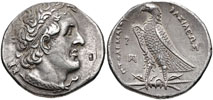
|
|
10998. EGYPT, PTOLEMAIC KINGS. PTOLEMY I SOTER. 305-282 BC. AR Tetradrachm (27mm, 15.65 g, 12h). Ptolemaic standard. Alexandreia mint. Struck in the name of Alexander III of Macedon, circa 304 BC. Diademed head of the deified Alexander right, wearing elephant skin headdress; small Δ in aegis / Athena Alkidemos advancing right; to right, helmet, monogram, and eagle standing right on thunderbolt. Svoronos 170; Jenkins, Early group d; SNG Copenhagen 27. VF, lightly toned, minor scratches and metal flaws. From the Fredy Vortisch Collection.
SOLD.
|
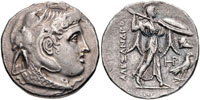
|
BERENIKE I, wife of Ptolemy I
|
10595. EGYPT, PTOLEMAIC KINGS. BERENIKE I or II. Mid 3rd century BC. AR Didrachm (19mm, 6.86 g). Kyrene or Alexandreia mint. Diademed and draped bust right / Club facing downward; monogram to left, trident head to right; all within wreath. Svoronos 318 (Berenike I); Caltabiano, Berenice, pl. I, 3 (Berenike II); SNG Copenhagen 429 (Berenike I); cf. BMC Ptolemies p. 60, 13 (Berenike II); BMC Cyrenaica p. 76, 11 (Berenike I); Noske -. VF, lightly toned, porous. Considerably better than photo. Scarce Ptolemaic portrait coin as most Ptolemaic issues feature the head of Zeus rather than likenesses of Ptolemaic rulers. Ex CNG.
These didrachms struck in the name of Berenike have been attributed to either Berenike I, wife of Ptolemy I, or Berenike II, wife of Ptolemy III. Even at the time of Svoronos' great corpus, there was no unanimity among prominent numismatists. While Svoronos favored an attribution to Berenike I, Poole (in BMC Ptol.), Head, and Muller preferred Berenike II. A full discussion of these attributions was taken up by Robinson in his introduction in BMC Cyrenaica (pp. cxlix-cliv). His argument supports an attribution to Berenike I, but much later than Svoronos' dating, to the period of Magas' revolt against Ptolemy II. His conclusions are largely based on the attribution of the bronze coinage in this period, and further refinements have necessitated a lowering of Robinson's dating, placing the Berenike coins in the period after the revolt, when Magas was reconciled to Ptolemy, circa 261-258 BC (cf. Buttrey, Coins, 199, and p. 55). Caltabiano, however, has assigned all of the coinage in the name of Berenike, both Egyptian and Kyrenaikan, to Berenike II, and dates them to the period that Berenike was regent while Ptolemy III was away fighting in the Third Syrian War. Much of her argument is based on control mark links she identifies between the Berenike coinage and that assigned to Ptolemy III and IV. Both theories have significant flaws. The attribution to Berenike I relies strongly on the dating of the bronze 'Koinon' coinage of Kyrenaika, but recent finds have suggested these issues may be later than previously thought. On the other hand, Caltabiano's linkage between the Kyrenaikan and Egyptian coinage in the name of Berenike is conjectural, and ignores the significance of the MAΓ monogram, which must be related to Magas (cf. BMC Cyr. p. cl). Perhaps the most important deficiency in analyzing this coinage is the absence of any known mixed-coinage hoard containing these didrachms. Discussion courtesy CNG. |
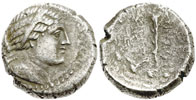
|
PTOLEMY II, PHILADELPHOS, 285-246 son of Ptolemy I
|
11985. PTOLEMAIC KINGS of EGYPT. PTOLEMY II, PHILADELPHOS, with Arsinoe II, Ptolemy I, and Berenike I. 285-246 BC. AV Half Mnaieion - "Tetradrachm" (19mm, 13.85 g, 12h). Alexandreia mint. Struck circa 272-261/0 BC. Conjoined busts of Ptolemy II and Arsinoe II right; Ptolemy is diademed and draped, Arsinoe is diademed and veiled; shield to left / Conjoined busts of Ptolemy I and Berenike I; Ptolemy is diademed and draped, Berenike is diademed and veiled. Svoronos 604; SNG Copenhagen 133; Noeske 38; Boston MFA 2275; Dewing 2753-4. VF, a few light marks and scuffs. Superior expressive portraits of all four rulers for these.
| 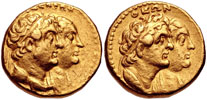 |
|
10356. PTOLEMY II, PHILADELPHOS, Kyrene mint. AE22. 285-246 v. Chr.. Bronze 285/283 v. Chr., Kyrene. Head of Ptolemy II right. / Head of Libya right. Svoronos 855 8.19 g. Chestnut brown patina, Nice VF. Scarce.
| 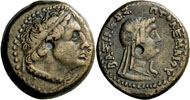 |
|
8587. EGYPT, PTOLEMY II, 285-246 BC. AE28, Sovoronos 7779v. Laureate head of Zeus r. of exceptionally fine style/Eagle stg. on thunderbolt l., shield to l. EF+. This is a very rare variety of the usual Ptolemaic type but of much finer style (see the Sear plate coin for the usual style) with a superbly rendered head of Zeus. This variant is quite rare and is usually found in Sicily. A choice example and deserving of further study.
In their recent study NumChron 171, available at: , Daniel Wolf and Catharine Lorber thoroughly examine a class of the 'Galatian shield' bronze coinage commonly given to the Alexandria mint. While the bronze issues with an enigmatic monogram of Σ with serifs above the shield can be attributed to the mint of Alexandria, those without this control exhibit distinguishing features, with provenances suggesting a Sicilian mint. While this theory of a western origin has been posited before, Wolf and Lorber present the first comprehensive investigation of the series, accompanied by a die study. Their analysis shows that the initial output of Sicilian 'Galatian shield' bronzes appear to have been produced under Alexandrian minting specialists, with related 'imitative' issues of 'Western Greek' style following this period of production under Ptolemaic authority. These 'Western Greek' style coins were struck with loose dies and share a common fabric, metrology, and border style with the Syracusan coinage of Hieron II, as well as featuring shared controls with the coinage struck in Hieron's name, all indicating a Sicilian mint's operation under Hieron superseding the Ptolemaic, or perhaps the wholesale transfer of the mint (if so, very likely to Syracuse). Commentary courtesy CNG.
|  |
|
9368. EGYPT, PTOLEMY II, 285-246 BC. AE46, 102 gm., Sear 7782. Laur. hd. Zeus Ammon r./Eagle stg. l. on thunderbolt looking back, no monograms. EF. Slight double striking on obv. Choice example of this largest of the Ptolemaic bronze coins and one of the largest and heaviest ancient coins struck. |
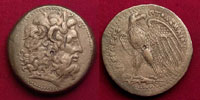
|
ARSINOE I, first wife of Ptolemy II, daughter of Lysimachos of Thrace, no coins?
ARSINOE II, daughter of Ptolemy I, wife of Lysimachos, sister and second wife of Ptolemy II
|
11231. EGYPT, ARSINOE II, wife of Ptolemy II, 285-246 BC. Arsinoe II, wife of Ptolemy II Philadelphos (died 270 BC). AR Dekadrachm (35-36 mm, 28.41 g), Alexandria. Struck under Ptolemy II Philadelphos c. 270-261/0 BC. Obv. Diademed and veiled head right wearing stephane, lotus-tipped scepter over left shoulder appearing again at top of head; A behind. Rev. APΣINOHΣ ΦIΛAΔEΛΦOY, filleted double cornucopiae with grape clusters. Svoronos 420; Troxell, Arsinoe Group 1; SNG Copenhagen 135 var. (different letter behind). Very rare. Very fine. Edge problems and scratches. In spite of the edge lamination a superbly styled clear portrait of this important Ptolemaic queen, much superior to most even on her large gold octodrachm issues. This Arsinoe dekadrachm is the first representation of a female monarch in numismatic art. Arsinoe, the sister and wife of Ptolemy II, was so influential that she was deified after her death and that her cult became very popular. |
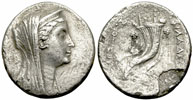
|
PTOLEMY III, EUERGETES, 246-222
|
10526. EGYPT, PTOLEMY III, 246-222 BC. AV Oktodrachm (27mm, 27.69 g, 12h). Alexandreia mint. Commemorative issue struck under Ptolemy IV, 221-205 BC. Bust of the deified Ptolemy III right, wearing radiate diadem and aegis; trident over left shoulder, middle prong ends in a lotus finial / BAΣIΛEΩΣ ΠTOΛEMAIOY, radiate and filleted cornucopia; ΔI below. Svoronos 1117; SNG Copenhagen 196; Noeske 137; BMC 103; Boston MFA 2283. Near EF, underlying luster, typical die rust. Rare. |
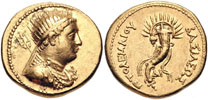
|
|
11866. EGYPT, PTOLEMY III, EUERGETES, 246-222 BC. AE Hemiobol (21mm, 6.64 g, 12h). Alexandreia mint. Struck 245 BC. Laureate bust right, wearing aegis / Eagle standing left on thunderbolt; to right, cornucopia. Svoronos 1000; Weiser 69; SNG Copenhagen 193-195. Good VF, choice green patina. An attractive example of this scarcer type. |
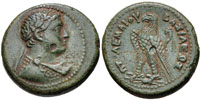
|
BERENIKE II, wife of Ptolemy III
|
10525. EGYPT, PTOLEMAIC KINGS, BERENIKE II, wife of Ptolemy III. Circa 244/3-221 BC. AE (22mm, 7.82 g, 11h). Ake-Ptolemais mint(?). Struck circa 224-222 BC. Diademed head right / Eagle standing left on thunderbolt; c/m: cornucopia within oval incuse. Svoronos 1055; SNG Copenhagen 460. Near VF, green patina. Rare. |
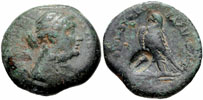
|
PTOLEMY IV, PHILOPATOR, 221-204
|
11764. EGYPT, PTOLEMY IV commemorative issue struck by Ptolemy V, 205-180. Tetradrachm, Alexandria 197, AR 14.05 g. Diademed and draped bust of the deified Ptolemy IV right. Rev. BASILEWS - PTOLEMAIOU Eagle standing l. on thunderbolt; between its legs, NI. In lower l. field, Q. Svoronos 1282. Extremely rare and in unusually fine condition for the issue. A very appealing portrait and a lovely old cabinet tone, extremely fine.
The portrait on this issue is often misidentified as that of Ptolemy V under whom the coin was struck. However when we compare the portrait to those of Ptolemy V (see his listing below) it is clearly that of a different older person and the only possible candidate would be the previous king, Ptolemy IV.
|
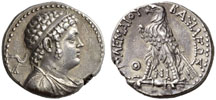
|
|
11026. EGYPT, PTOLEMY IV, 222-205/4 BC. AR Tetradrachm (26mm, 13.39 g, 12h). Alexandreia mint. Jugate busts of Zeus Serapis, laureate and draped, and Isis, wreathed and draped right; small cap of Osiris above Serapis, globe and horns above Isis / Eagle standing left on thunderbolt; filleted cornucopia over shoulder, ΔI between legs. Svoronos 1124; SNG Copenhagen 197-8. Good VF, EF reverse. lightly toned, minor porosity and hairline flan crack. Scarce and attractive. |

|
ARSINOE III, sister and wife of Ptolemy IV
|
10999. EGYPT, PTOLEMAIC KINGS OF EGYPT. ARSINOE III PHILOPATOR, wife of Ptolemy IV. 220-204 BC. AE (12mm, 1.47 g, 12h). Paphos mint. Diademed and draped bust right / Double cornucopia tied with fillet. Svoronos 1161; SNG Copenhagen 650. Near VF, dark green patina, edge split. |
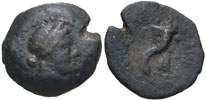
|
PTOLEMY V, EPIPHANES, 204-180
|
10432. EGYPT, PTOLEMY V EPIPHANES. 205-180 BC. AR Tetradrachm (26mm, 13.56 g, 12h). Uncertain Phoenician mint. Year M(12) = 193 BC. Diademed (with barley ear on it) and draped bust right of the young Ptolemy V. / Eagle standing left on thunderbolt, with wings closed; M (date) before, NI between eagle's legs. Svoronos 1284 (types same as 1274); SNG Copenhagen -; Morkholm, "The Portrait Coinage of Ptolemy V: The Main Series," Essays Thompson (A20/P55). VF, light porosity, some cleaning scratches. Rare Ptolemaic silver with portrait of issuing king. |
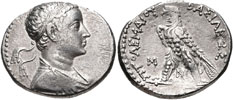
|
CLEOPATRA I, wife of Ptolemy V, daughter of Antiochos III,
|
9372. EGYPT, PTOLEMY V AND CLEOPATRA I, 204-180 BC, AE26, BMC 72, Sear 7880. Hd. Cleopatra I as Isis/Eagle stg. l. with spread wings. EF. Choice example (reverse significantly sharper than image shows).
|

|
|
9373. EGYPT, PTOLEMY V AND CLEOPATRA I, 204-180 BC, AE26, BMC 72, Sear 7880. Hd. Cleopatra I as Isis/Eagle stg. l. with spread wings. VF+. Choice example of wonderful esthetic style and with fine chocolate patina. |

|
PTOLEMY VI, PHILOMETOR, 180-145
|
11233. EGYPT, PTOLEMY VI. AR Didrachm (18 mm, 5.89 g), Paphos mint. late 2nd Century BC. Obv. Draped bust of Ptolemy VI as the youthful Dionysos right, crowned with ivy, aegis round breast, thyrsos over left shoulder. Rev. BAΣIΛEΩΣ ΠTOΛEMAIOY, Eagle with open wings standing left on thunderbolt.
Svoronos 1798; SNG Copenhagen 637; Noeske 174, 385; Hazzard C1122, fig. 144. Rare. Somewhat rough surfaces, Near VF.
|
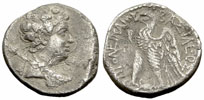
|
|
10871. EGYPT, PTOLEMY VI PHOENICIA. (199/8-169/8). Marathos mint in Phoenicia. Obv: Laureate and draped bust of Ptolemy VI as Hermes right, with kerykeion over shoulder. Rev: Marathos standing slightly left, holding aphlaston; date to left. Rouvier IV, cf. 138, 806ff. Condition: Very fine. Weight: 7.3 gm. Diameter: AE19 mm. Scarce portrait coin of Ptolemy VI. |
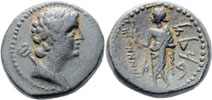
|
CLEOPATRA II, sister and wife of Ptolemy VI, then sister and wife of Ptolemy VIII
|
11322. EGYPT, CLEOPATRA II, Marathos mint in Phoenicia. 221/0-152/1 BC. AE(22mm, 11.38 g, 1h). Dated CY 98 (162/1 BC). Veiled female head right (traditionally considered to be Cleopatra II though a few argue it depicts Cleopatra III) / Marathos standing left holding aphlaston and leaning on short column. Duyrat, Ateliers Series 4, 115-121; BMC 7; DCA 830; HGC 10, 193. VF, dark brown patina with some earthen highlights. Scarce portrait coin of Cleopatra II.
While the portrait on this coin is sometimes identified as Berenike II it actually is almost certainly that of Cleopatra II who was queen of Egypt when it was minted in 162/1 BC.
|

|
PTOLEMY VII, NEOS PHILOPATOR, 145-144. son of Ptolemy VI and Cleopatra II, no portrait coins
PTOLEMY VIII, EUERGETES, 145-116 BC. Didrachm of Paphos, Sear 7913
|
11232. IMPORTANT UNPUBLISHED? PTOLEMAIC RARITY. EGYPT, PTOLEMY VIII, EUERGETES (145-116 BC). AE45 (57.74 g), Cyprus mint, 131 BC or slightly later. Obv. Head of Zeus Ammon wearing taenia and ram's horn right. Rev. EYEPΓETOY BAΣIΛEΩΣ ΠTOΛEMAIOY, single cornucopia decorated with taenias.
Cf. Svoronos pl. 267, 1640 var. (double cornucopia). Extremely rare, apparently unpublished. Good very fine.
This fascinating rarity with a single rather than a double cornucopia belongs to the short Ptolemaic civil war period between 132 and 127/6 BC. In 132 BC, war broke out between the king and his first wife Cleopatra II, formerly married to the king's predecessor and brother Ptolemy VI. Although he lost most of Egypt, he was able to hold the capital Alexandria until late in 131 BC, when the royal palace was burned down and Ptolemy had to flee with his second wife Cleopatra III (who was the daughter of Cleopatra II and thus his niece) to Cyprus. Late in 131 or early in 130 BC, he returned to Egypt and regained control over most of the country, although Cleopatra would hold Alexandria until about 127/6 BC, soon after which the royal family settled its quarrels. It is during the civil war period that this extremely rare type must have been issued. |
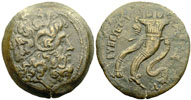
|
CLEOPATRA THEA, daughter of Ptolemy VI and Cleopatra II, wife of Seleucid kings Alexander Balas, Demetrios II, Antiochos VII, see her coins in the Seleucid section
PTOLEMY IX, SOTER, 116-106 and 88-80, oldest son of Ptolemy VIII and Cleopatra III, no portrait coins
PTOLEMY X, ALEXANDER, 106-88, youngest son of Ptolemy VIII and Cleopatra III, some tetradrachms of Ascalon may depict him
PTOLEMY XI, 80, son of Ptolemy X by his unknown first wife, no known coins
PTOLEMY XII, NEOS DIONYSOS, 80-58 & 55-51 BC. son of Ptolemy IX by a Greek concubine, father of Cleopatra VII. AR Drachm Sear 7949 (also possibly a tetradrachm of Askalon (99-64BC) struck on the Ptolemaic standard. SNG ANS 650, Baldwin's 80 lot 2036)
CLEOPATRA VII, THEA NEOTERA, 51-30, lover of Julius Caesar and Marc Antony, daughter of Ptolemy XII and Cleopatra VI, (issues with Marc Antony are to be found on our Roman Imperatorial coins page)
|
CLEOPATRA OF EGYPT
9421. SCARCE PORTRAIT COIN OF THE FAMOUS CLEOPATRA OF EGYPT. EGYPT, CLEOPATRA VII, 51-30 BC. AE25 80 drachma, 16.67 g, BMC 4-5. Draped bust with diadem r./Eagle stg. on thunderbolt l., double cornucopia. RR! Good Fine with nice portrait for these.
 $4000. $4000.
|
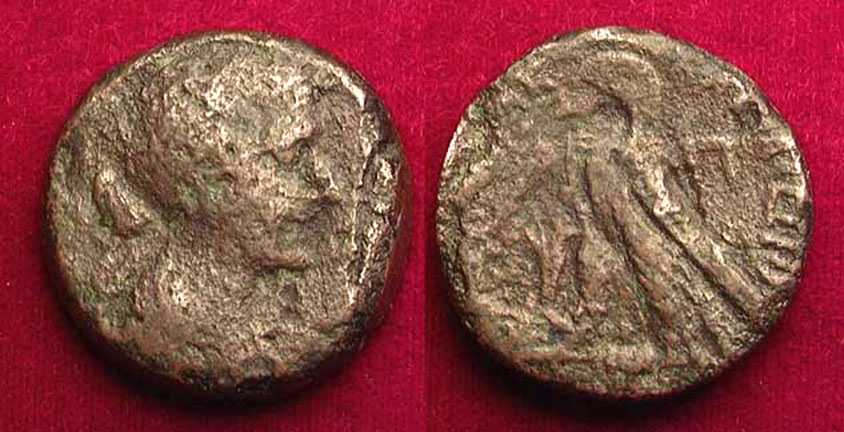
|
PTOLEMY XIII, 51-47, brother of Cleopatra VII and temporary co-ruler with her, some tetradrachms of Ascalon may depict him
PTOLEMY XIV, 47-44, brother of Cleopatra VII and temporary co-ruler with her, no coins
PTOLEMY XV, CAESARION, 44-30, son of Cleopatra VII and Julius Caesar, temporary co-ruler with his mother, appears with his mother on a single coin type
CLEOPATRA SELENE, daughter of Cleopatra VII, wife and queen of Juba II of Mauretania
|
DAUGHTER OF CLEOPATRA VII OF EGYPT?
11864. KINGS of MAURETANIA. CLEOPATRA SELENE? Struck by Juba II. 25 BC-AD 24. AE 4 Units (34mm, 32.32 g, 1h). Caesarea mint. Draped bust of Africa right, wearing elephant's skin headdress; [two spears over shoulder] / Eagle standing right on thunderbolt; scepter to right; all within laurel wreath. MAA 208; SNG Copenhagen 618. Near Fine, green patina, a few pits. Rare. Provenance: The Continental Collection.
One must suspect this intriguing coin carries the portrait of Cleopatra Selene of Egypt due to the Ptolemaic eagle on thunderbolt on the reverse which seems to indicate her origin in Egypt as a member of the Ptolemaic lineage.
|

|
PTOLEMY KING OF MAURETANIA, son of Cleopatra Selene and King Juba, last of the Ptolemaic Dynasty
|
LAST OF THE PTOLEMIES
12947. KINGS of MAURETANIA. JUBA II, with PTOLEMY OF MAURITANIA. 25 BC-AD 24. AR Denarius (17mm, 3.26 g, 6h). Caesaraea mint. Dated RY 36? (AD 10/1?). Head of Juba as Herakles right, wearing lion skin / Diademed and draped bust of Ptolemy left; [date in legend]. MAA - (unrecorded pairing of types D/W); SNG Copenhagen -. VF, toned, off center, scrape on reverse.
SOLD.
|
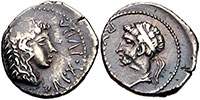
|
KYRENE
|
11863. KYRENAICA, KYRENE. temp. Magas. As Ptolemaic governor, first reign, circa 300-282/75 BC. AR Didrachm (20mm, 7.66 g, 12h). Head of Karneios left / Silphion plant; coiled serpent to left, I and ΠO monogram to right. SNG Copenhagen 1239; BMC 244-5. VF, toned. Well centered and struck. Provenance: The Continental Collection; Kunker auction 182, lot 392, 3/14/11 (2200 Euro).
The silphium or silphion plant depicted on the reverse of this coin was one the most famous medicinal plants of the ancient world and the primary export from Kyrene on the coast of N. Africa in modern Libya. A large plant of the fennel family it was very effective as a contraceptive and abortifacient. It also had additional medicinal uses and was even used in cooking. Demand for the plant was so great that it was apparently harvested to extinction in ancient times and the last known plant was said to have been presented to the emperor Nero as a gift. Thought to have been extinct since then some recent reports have claimed to have found small patches still growing in the wild in the Magreb.
The seed of the silphium plant was heart shaped and depicted thus on some of the smaller coins of Kyrene. In fact it may well be the original source of the heart shaped symbol now universally used to connote love because of the silphium's strong sexual connotations in antiquity.
|  |
























